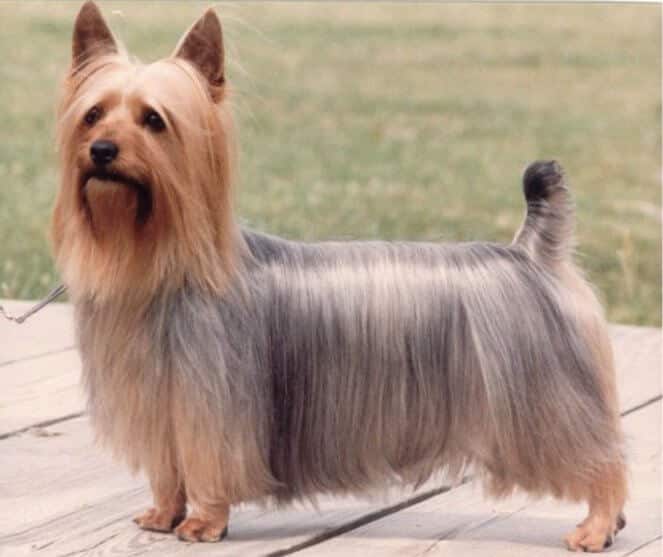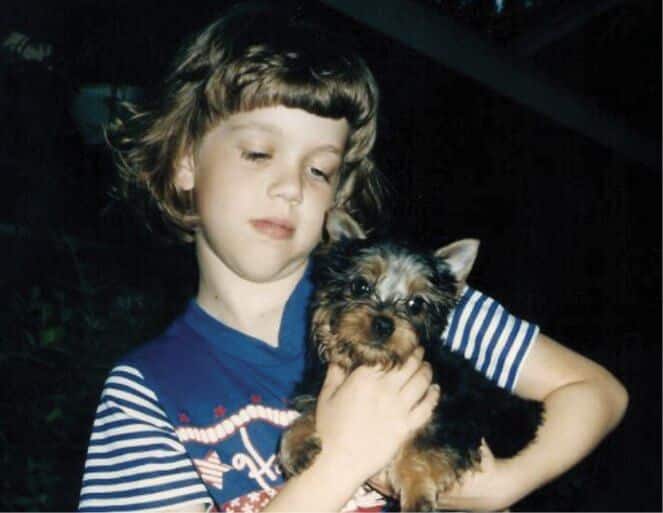
Home » Silky Terrier Guide

Silky Terriers are fine-boned but with substance of muscle, built low to the ground and slightly longer than their height. A wedge-shaped head defines the breed as a Terrier, and small, V-shaped, erect ears give proof to their alert attitude. A Silky has a level topline, with a docked tail carried at the 12 o’clock to 2 o’clock position. Dark, almond-shaped eyes have a keen expression. The blue and tan coat is single, straight, and flat. The tight, cat-like feet are indicative of the breed, as is the raising of one front foot when on the alert. Average life span is between 14-17 years. Approximate weight is 10-11 lbs., with height at approximately 10 inches.

Silkys need owners who are the “alpha” of the pack or they will “take over” the position themselves. A Silky is a very good alarm dog that is cautious and protective of “their” family. A Silky is very smart, brave, loving, energetic, curious, stubborn at times, tenacious and, at times, can resist training, but… with proper positive training, can learn quickly. They are very food-driven and will work for attention. A Silky does need early socialization to all types of outside activities—people, dogs, and travel. Silkys make wonderful pets for children who are good with animals. Not all Silkys are good around small children, as the breed can be a bit robust and overpowering for children under five. Silkys can become protective when not properly socialized and become “fear biters.”

Silkys are very energetic and active; definitely need a secure, fenced yard. It is never advisable to leave your Silky for long times in the “fenced yard” as they will become bored and “look” to be with their people. They can be escape artists. A Silky may live in an apartment, but will need plenty of walks and “could” be a barking problem as they will “alert” to noises they hear outside. ON LEASH ALWAYS!
Silkys are a “single-coated” breed (meaning no undercoat). Grooming is minimal, but a daily brushing is required to keep mats and tangles from forming. A weekly bath (or when needed) followed with a leave-in conditioner is good. A little tidy upkeep on the ears, feet, and tail is really all that is needed.

Overall, Silkys are very healthy dogs, but any of the below may appear occasionally:
A Silky is said to never forget a face, and I have found this to be very true. Housebreaking can be a challenge, as you must be very consistent in your training. A Silky must be an integral part of your “family” or they will otherwise not be happy—and neither will you. Silkys are very active and do very well in Agility or fast-paced events. A bit of Basic Obedience is always necessary, but it really is too structured for the Silky Terrier personality. A very young puppy is not the best in homes with very small children or the very elderly. An adult may work better in these situations, if properly socialized at young age. Men generally enjoy a Silky as they are not a “foo foo” dog but a “real” dog and, given the opportunity, they will prove it daily.

The Silky Terrier breed originated in Australia. In breeding the Australian Terrier, the breeders were occasionally having “soft coated” pups in their litters. Some decided that they liked this look and interbred with Yorkshire Terriers to increase the coat factor for single-coated pups with the same black and tan markings. What evolved is a breed between the Australian Terrier and Yorkshire Terrier in size and coat type. The first Silky Terriers went by several names in the different states within Australia. Some were called the Australian Silky Terrier while other areas called them the Sydney Silky Terrier. As the breed became more stable and bred true to type, a dog of approximately 10 inches at the shoulder, blue and tan in color, with a silky, single-haired coat (resembling an Australian Terrier body more than a Yorkshire Terrier) evolved. A Silky is longer in body than height at the shoulders, has a strong wedge-shaped head, erect ears sitting on top of the head, a strong set of teeth, and strength of muscle to do the job of keeping the home clear of varmints. The breed is a free spirit with free movement and a friendly nature. There is still some confusion today as to the name of the Silky Terrier. ONLY in the United States is the breed known as the “Silky Terrier” by AKC. In all other countries it is known as the Australian Silky Terrier and is even in the Terrier Group in many countries. In 1959, AKC was about to recognize both the Australian Terrier and the Australian Silky Terrier. AKC made the decision to drop “Australian” from the Silky Terrier and placed the Australian Terrier in the Terrier Group while the Silky Terrier was placed in the Toy Group. Nonetheless, a Silky is a Terrier, and never doubt this when making the decision to own one.
Silky Terrier Guide
(A version of this article appeared in the February 2014 edition of SHOWSIGHT.)